Analyzing Pre and Post Referendum Policies and Indigenous Australians
VerifiedAdded on 2022/08/23
|8
|2049
|13
Essay
AI Summary
This essay provides a comprehensive analysis of the pre and post-referendum policies affecting Indigenous Australians, focusing on the historical context surrounding the 1967 Referendum. It examines the initial hopes and subsequent realities of the referendum, highlighting the displacement and marginalization faced by Indigenous communities since European settlement. The essay explores the flaws in the referendum process, the challenges faced by Indigenous Australians in the military, and the implementation of assimilationist policies. It also discusses the Whitlam government's policy of self-determination and its impact. The essay emphasizes the ongoing struggles for recognition, land rights, and social justice, concluding with a call for greater inclusion in media and government efforts to improve living conditions.
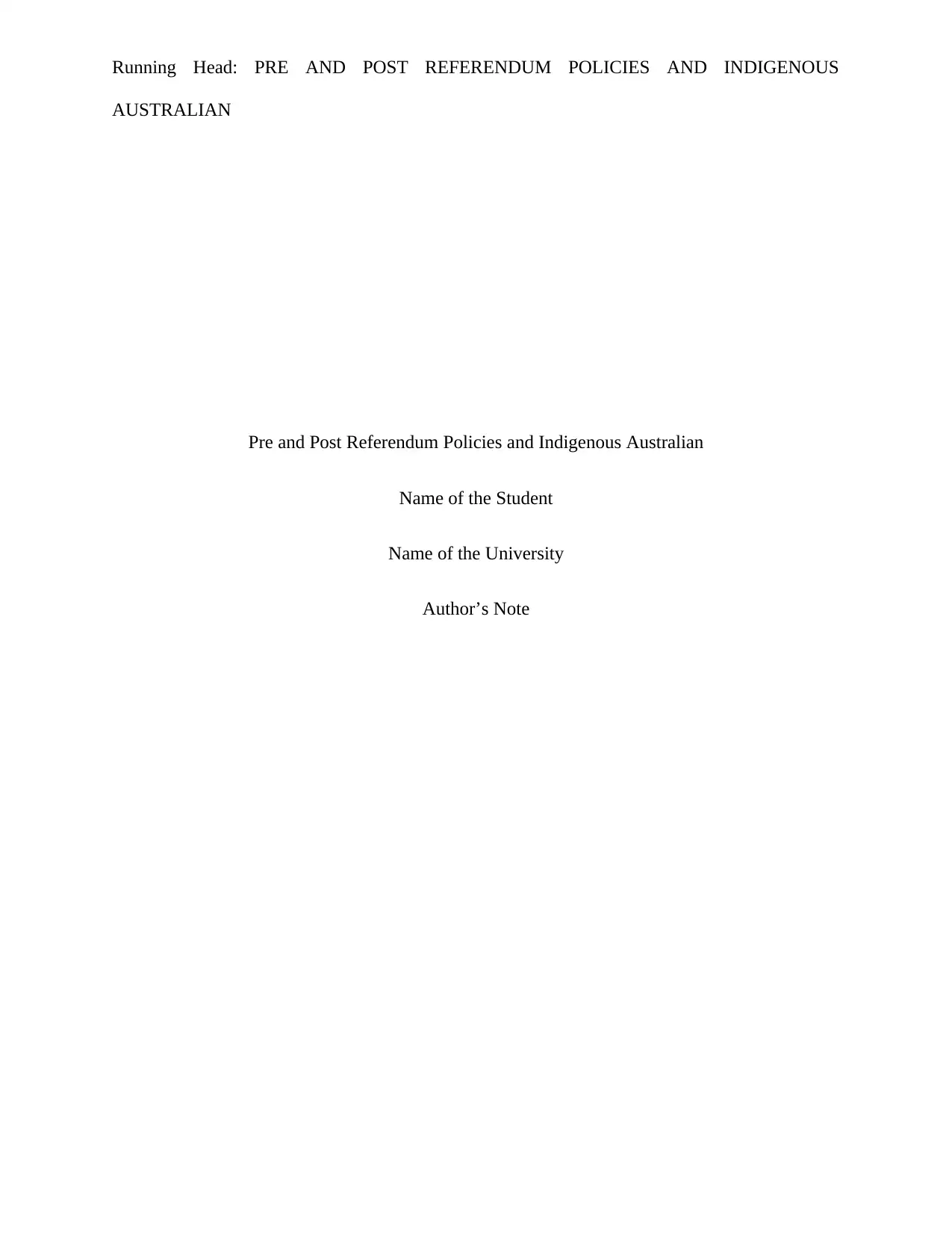
Running Head: PRE AND POST REFERENDUM POLICIES AND INDIGENOUS
AUSTRALIAN
Pre and Post Referendum Policies and Indigenous Australian
Name of the Student
Name of the University
Author’s Note
AUSTRALIAN
Pre and Post Referendum Policies and Indigenous Australian
Name of the Student
Name of the University
Author’s Note
Paraphrase This Document
Need a fresh take? Get an instant paraphrase of this document with our AI Paraphraser
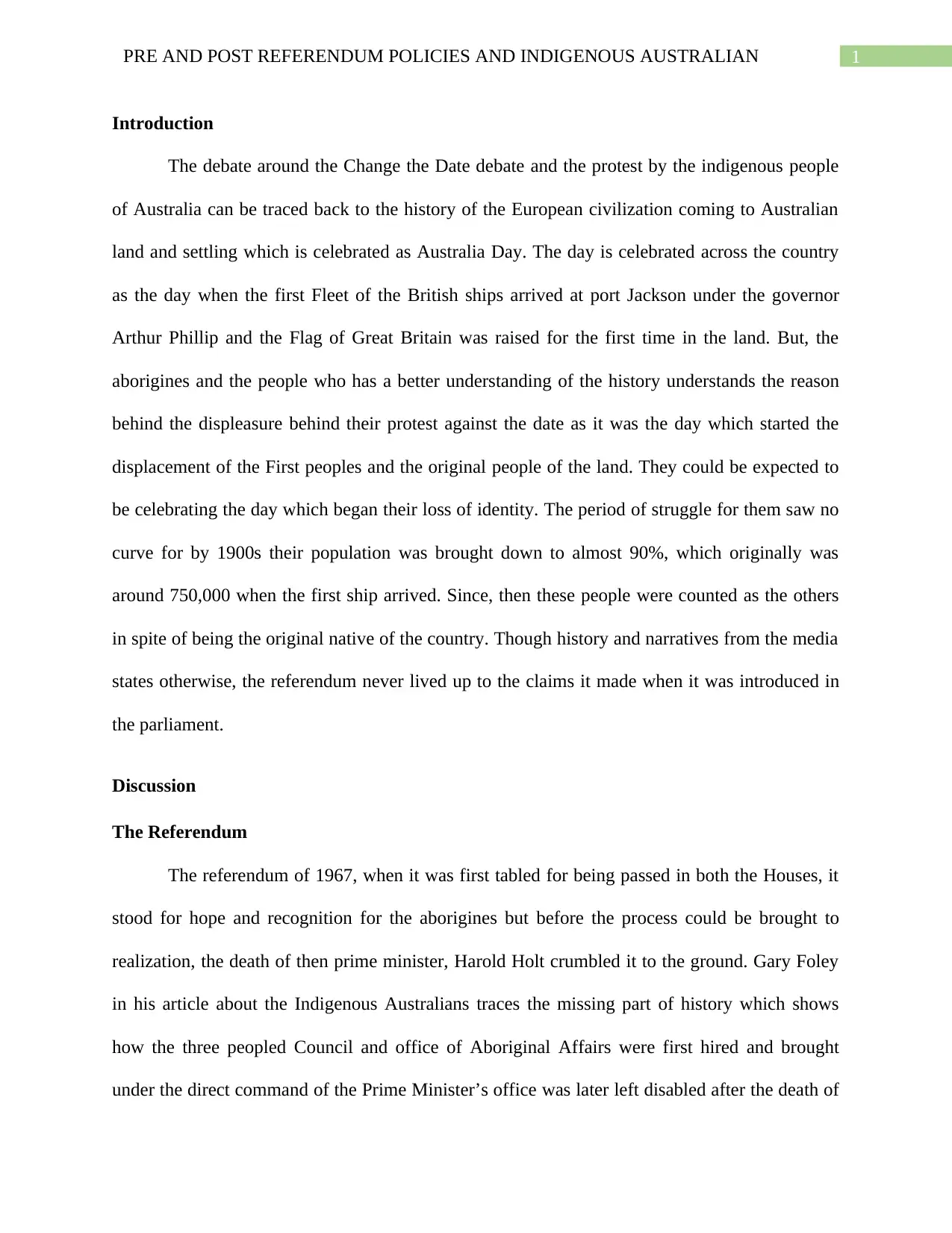
1PRE AND POST REFERENDUM POLICIES AND INDIGENOUS AUSTRALIAN
Introduction
The debate around the Change the Date debate and the protest by the indigenous people
of Australia can be traced back to the history of the European civilization coming to Australian
land and settling which is celebrated as Australia Day. The day is celebrated across the country
as the day when the first Fleet of the British ships arrived at port Jackson under the governor
Arthur Phillip and the Flag of Great Britain was raised for the first time in the land. But, the
aborigines and the people who has a better understanding of the history understands the reason
behind the displeasure behind their protest against the date as it was the day which started the
displacement of the First peoples and the original people of the land. They could be expected to
be celebrating the day which began their loss of identity. The period of struggle for them saw no
curve for by 1900s their population was brought down to almost 90%, which originally was
around 750,000 when the first ship arrived. Since, then these people were counted as the others
in spite of being the original native of the country. Though history and narratives from the media
states otherwise, the referendum never lived up to the claims it made when it was introduced in
the parliament.
Discussion
The Referendum
The referendum of 1967, when it was first tabled for being passed in both the Houses, it
stood for hope and recognition for the aborigines but before the process could be brought to
realization, the death of then prime minister, Harold Holt crumbled it to the ground. Gary Foley
in his article about the Indigenous Australians traces the missing part of history which shows
how the three peopled Council and office of Aboriginal Affairs were first hired and brought
under the direct command of the Prime Minister’s office was later left disabled after the death of
Introduction
The debate around the Change the Date debate and the protest by the indigenous people
of Australia can be traced back to the history of the European civilization coming to Australian
land and settling which is celebrated as Australia Day. The day is celebrated across the country
as the day when the first Fleet of the British ships arrived at port Jackson under the governor
Arthur Phillip and the Flag of Great Britain was raised for the first time in the land. But, the
aborigines and the people who has a better understanding of the history understands the reason
behind the displeasure behind their protest against the date as it was the day which started the
displacement of the First peoples and the original people of the land. They could be expected to
be celebrating the day which began their loss of identity. The period of struggle for them saw no
curve for by 1900s their population was brought down to almost 90%, which originally was
around 750,000 when the first ship arrived. Since, then these people were counted as the others
in spite of being the original native of the country. Though history and narratives from the media
states otherwise, the referendum never lived up to the claims it made when it was introduced in
the parliament.
Discussion
The Referendum
The referendum of 1967, when it was first tabled for being passed in both the Houses, it
stood for hope and recognition for the aborigines but before the process could be brought to
realization, the death of then prime minister, Harold Holt crumbled it to the ground. Gary Foley
in his article about the Indigenous Australians traces the missing part of history which shows
how the three peopled Council and office of Aboriginal Affairs were first hired and brought
under the direct command of the Prime Minister’s office was later left disabled after the death of
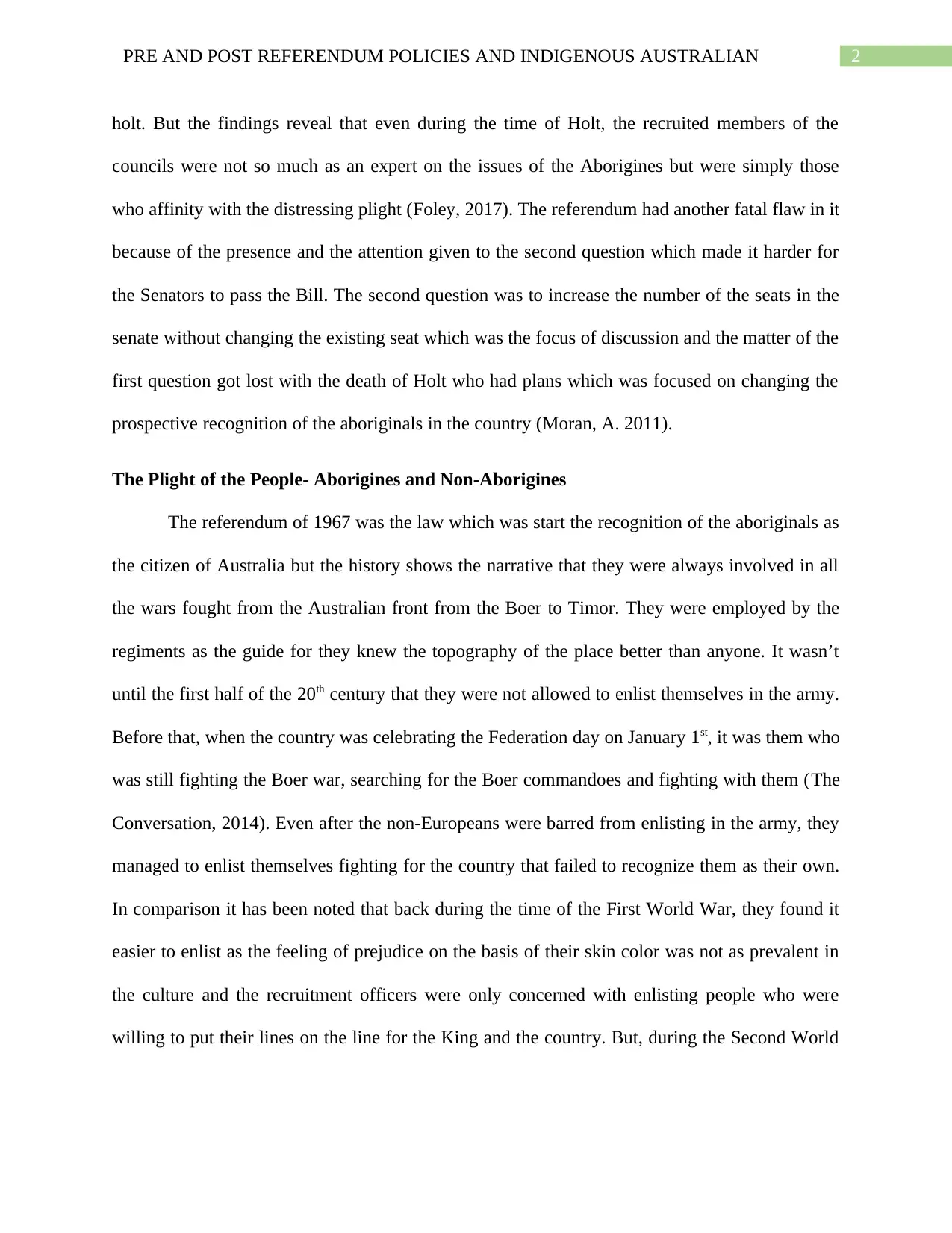
2PRE AND POST REFERENDUM POLICIES AND INDIGENOUS AUSTRALIAN
holt. But the findings reveal that even during the time of Holt, the recruited members of the
councils were not so much as an expert on the issues of the Aborigines but were simply those
who affinity with the distressing plight (Foley, 2017). The referendum had another fatal flaw in it
because of the presence and the attention given to the second question which made it harder for
the Senators to pass the Bill. The second question was to increase the number of the seats in the
senate without changing the existing seat which was the focus of discussion and the matter of the
first question got lost with the death of Holt who had plans which was focused on changing the
prospective recognition of the aboriginals in the country (Moran, A. 2011).
The Plight of the People- Aborigines and Non-Aborigines
The referendum of 1967 was the law which was start the recognition of the aboriginals as
the citizen of Australia but the history shows the narrative that they were always involved in all
the wars fought from the Australian front from the Boer to Timor. They were employed by the
regiments as the guide for they knew the topography of the place better than anyone. It wasn’t
until the first half of the 20th century that they were not allowed to enlist themselves in the army.
Before that, when the country was celebrating the Federation day on January 1st, it was them who
was still fighting the Boer war, searching for the Boer commandoes and fighting with them (The
Conversation, 2014). Even after the non-Europeans were barred from enlisting in the army, they
managed to enlist themselves fighting for the country that failed to recognize them as their own.
In comparison it has been noted that back during the time of the First World War, they found it
easier to enlist as the feeling of prejudice on the basis of their skin color was not as prevalent in
the culture and the recruitment officers were only concerned with enlisting people who were
willing to put their lines on the line for the King and the country. But, during the Second World
holt. But the findings reveal that even during the time of Holt, the recruited members of the
councils were not so much as an expert on the issues of the Aborigines but were simply those
who affinity with the distressing plight (Foley, 2017). The referendum had another fatal flaw in it
because of the presence and the attention given to the second question which made it harder for
the Senators to pass the Bill. The second question was to increase the number of the seats in the
senate without changing the existing seat which was the focus of discussion and the matter of the
first question got lost with the death of Holt who had plans which was focused on changing the
prospective recognition of the aboriginals in the country (Moran, A. 2011).
The Plight of the People- Aborigines and Non-Aborigines
The referendum of 1967 was the law which was start the recognition of the aboriginals as
the citizen of Australia but the history shows the narrative that they were always involved in all
the wars fought from the Australian front from the Boer to Timor. They were employed by the
regiments as the guide for they knew the topography of the place better than anyone. It wasn’t
until the first half of the 20th century that they were not allowed to enlist themselves in the army.
Before that, when the country was celebrating the Federation day on January 1st, it was them who
was still fighting the Boer war, searching for the Boer commandoes and fighting with them (The
Conversation, 2014). Even after the non-Europeans were barred from enlisting in the army, they
managed to enlist themselves fighting for the country that failed to recognize them as their own.
In comparison it has been noted that back during the time of the First World War, they found it
easier to enlist as the feeling of prejudice on the basis of their skin color was not as prevalent in
the culture and the recruitment officers were only concerned with enlisting people who were
willing to put their lines on the line for the King and the country. But, during the Second World
⊘ This is a preview!⊘
Do you want full access?
Subscribe today to unlock all pages.

Trusted by 1+ million students worldwide
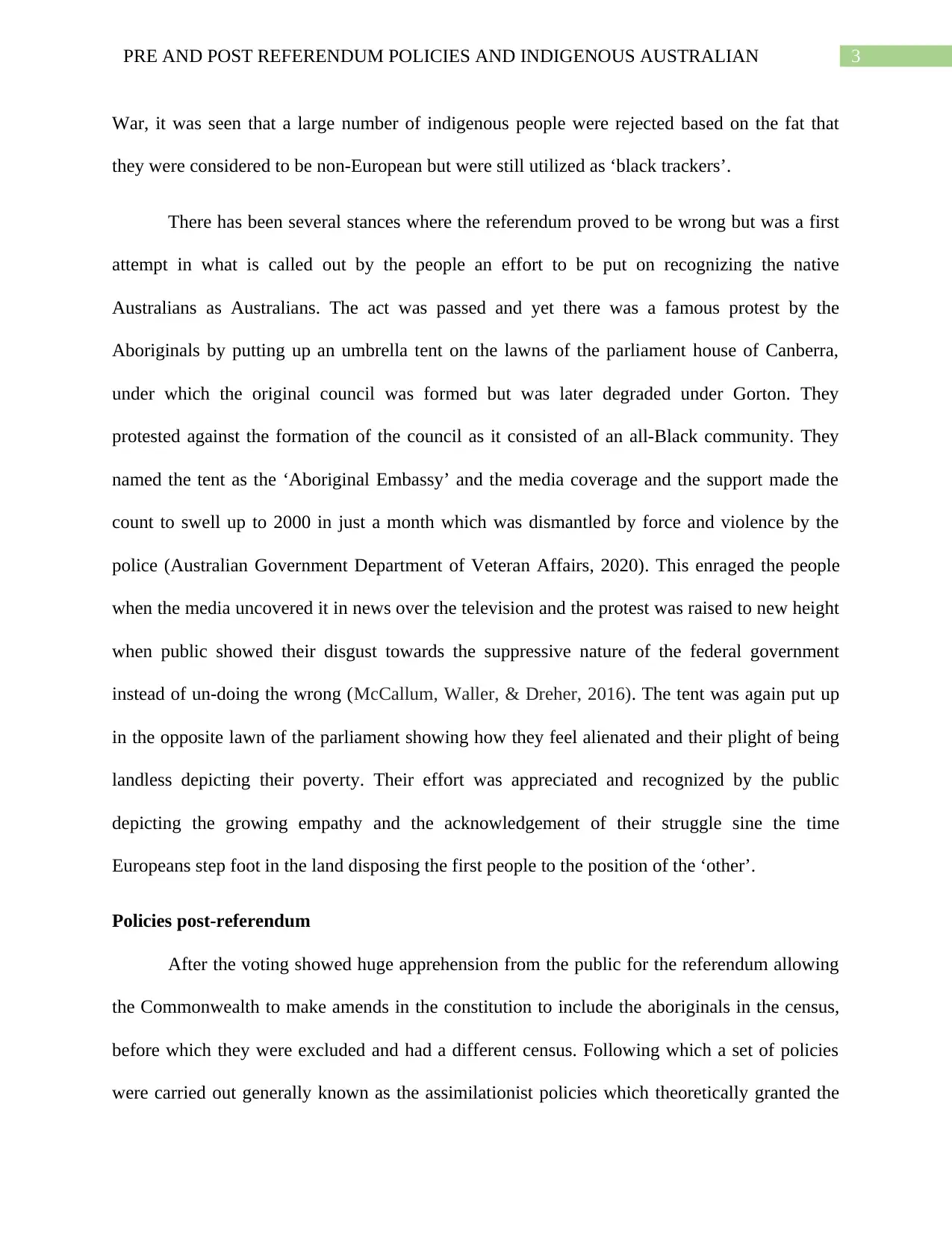
3PRE AND POST REFERENDUM POLICIES AND INDIGENOUS AUSTRALIAN
War, it was seen that a large number of indigenous people were rejected based on the fat that
they were considered to be non-European but were still utilized as ‘black trackers’.
There has been several stances where the referendum proved to be wrong but was a first
attempt in what is called out by the people an effort to be put on recognizing the native
Australians as Australians. The act was passed and yet there was a famous protest by the
Aboriginals by putting up an umbrella tent on the lawns of the parliament house of Canberra,
under which the original council was formed but was later degraded under Gorton. They
protested against the formation of the council as it consisted of an all-Black community. They
named the tent as the ‘Aboriginal Embassy’ and the media coverage and the support made the
count to swell up to 2000 in just a month which was dismantled by force and violence by the
police (Australian Government Department of Veteran Affairs, 2020). This enraged the people
when the media uncovered it in news over the television and the protest was raised to new height
when public showed their disgust towards the suppressive nature of the federal government
instead of un-doing the wrong (McCallum, Waller, & Dreher, 2016). The tent was again put up
in the opposite lawn of the parliament showing how they feel alienated and their plight of being
landless depicting their poverty. Their effort was appreciated and recognized by the public
depicting the growing empathy and the acknowledgement of their struggle sine the time
Europeans step foot in the land disposing the first people to the position of the ‘other’.
Policies post-referendum
After the voting showed huge apprehension from the public for the referendum allowing
the Commonwealth to make amends in the constitution to include the aboriginals in the census,
before which they were excluded and had a different census. Following which a set of policies
were carried out generally known as the assimilationist policies which theoretically granted the
War, it was seen that a large number of indigenous people were rejected based on the fat that
they were considered to be non-European but were still utilized as ‘black trackers’.
There has been several stances where the referendum proved to be wrong but was a first
attempt in what is called out by the people an effort to be put on recognizing the native
Australians as Australians. The act was passed and yet there was a famous protest by the
Aboriginals by putting up an umbrella tent on the lawns of the parliament house of Canberra,
under which the original council was formed but was later degraded under Gorton. They
protested against the formation of the council as it consisted of an all-Black community. They
named the tent as the ‘Aboriginal Embassy’ and the media coverage and the support made the
count to swell up to 2000 in just a month which was dismantled by force and violence by the
police (Australian Government Department of Veteran Affairs, 2020). This enraged the people
when the media uncovered it in news over the television and the protest was raised to new height
when public showed their disgust towards the suppressive nature of the federal government
instead of un-doing the wrong (McCallum, Waller, & Dreher, 2016). The tent was again put up
in the opposite lawn of the parliament showing how they feel alienated and their plight of being
landless depicting their poverty. Their effort was appreciated and recognized by the public
depicting the growing empathy and the acknowledgement of their struggle sine the time
Europeans step foot in the land disposing the first people to the position of the ‘other’.
Policies post-referendum
After the voting showed huge apprehension from the public for the referendum allowing
the Commonwealth to make amends in the constitution to include the aboriginals in the census,
before which they were excluded and had a different census. Following which a set of policies
were carried out generally known as the assimilationist policies which theoretically granted the
Paraphrase This Document
Need a fresh take? Get an instant paraphrase of this document with our AI Paraphraser
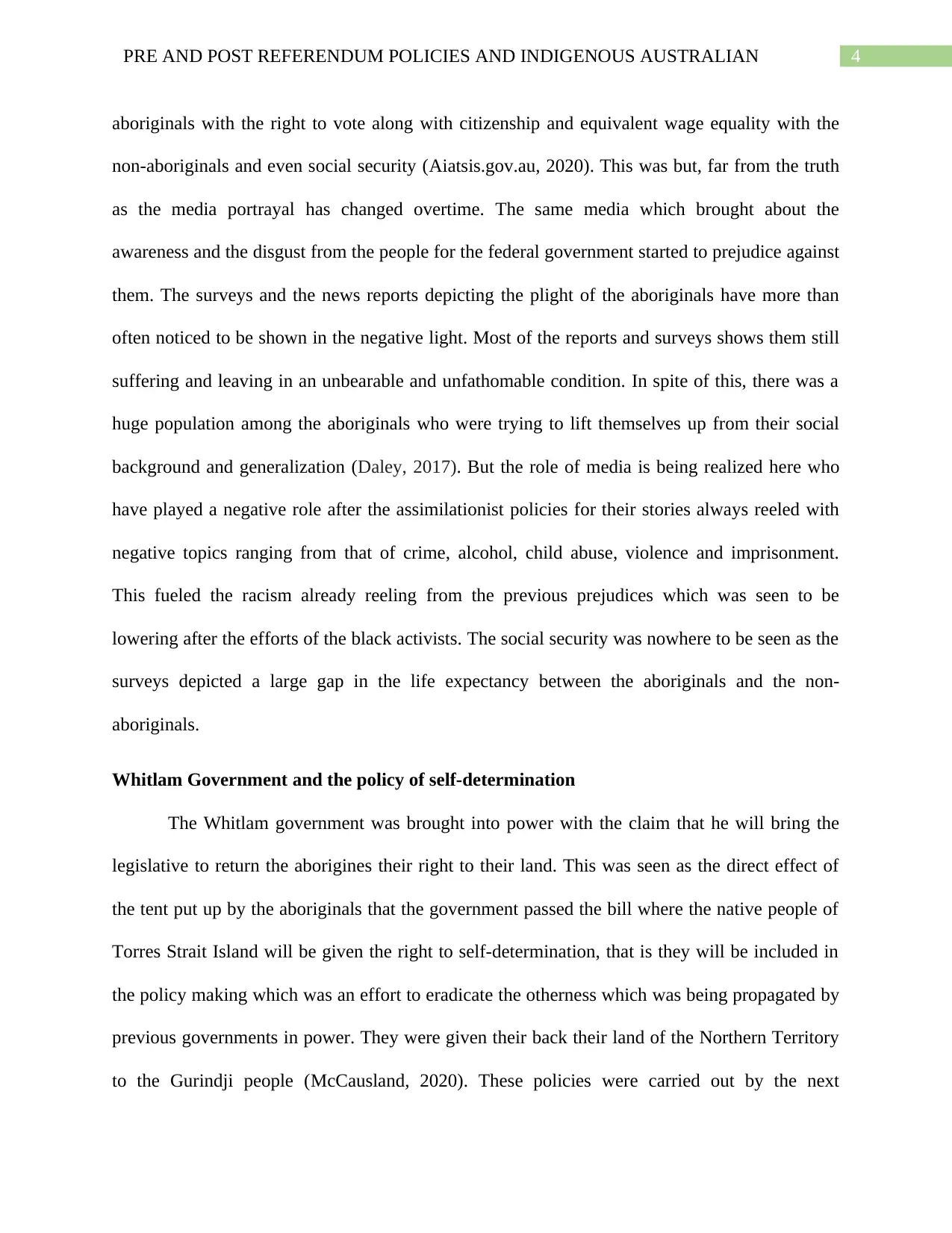
4PRE AND POST REFERENDUM POLICIES AND INDIGENOUS AUSTRALIAN
aboriginals with the right to vote along with citizenship and equivalent wage equality with the
non-aboriginals and even social security (Aiatsis.gov.au, 2020). This was but, far from the truth
as the media portrayal has changed overtime. The same media which brought about the
awareness and the disgust from the people for the federal government started to prejudice against
them. The surveys and the news reports depicting the plight of the aboriginals have more than
often noticed to be shown in the negative light. Most of the reports and surveys shows them still
suffering and leaving in an unbearable and unfathomable condition. In spite of this, there was a
huge population among the aboriginals who were trying to lift themselves up from their social
background and generalization (Daley, 2017). But the role of media is being realized here who
have played a negative role after the assimilationist policies for their stories always reeled with
negative topics ranging from that of crime, alcohol, child abuse, violence and imprisonment.
This fueled the racism already reeling from the previous prejudices which was seen to be
lowering after the efforts of the black activists. The social security was nowhere to be seen as the
surveys depicted a large gap in the life expectancy between the aboriginals and the non-
aboriginals.
Whitlam Government and the policy of self-determination
The Whitlam government was brought into power with the claim that he will bring the
legislative to return the aborigines their right to their land. This was seen as the direct effect of
the tent put up by the aboriginals that the government passed the bill where the native people of
Torres Strait Island will be given the right to self-determination, that is they will be included in
the policy making which was an effort to eradicate the otherness which was being propagated by
previous governments in power. They were given their back their land of the Northern Territory
to the Gurindji people (McCausland, 2020). These policies were carried out by the next
aboriginals with the right to vote along with citizenship and equivalent wage equality with the
non-aboriginals and even social security (Aiatsis.gov.au, 2020). This was but, far from the truth
as the media portrayal has changed overtime. The same media which brought about the
awareness and the disgust from the people for the federal government started to prejudice against
them. The surveys and the news reports depicting the plight of the aboriginals have more than
often noticed to be shown in the negative light. Most of the reports and surveys shows them still
suffering and leaving in an unbearable and unfathomable condition. In spite of this, there was a
huge population among the aboriginals who were trying to lift themselves up from their social
background and generalization (Daley, 2017). But the role of media is being realized here who
have played a negative role after the assimilationist policies for their stories always reeled with
negative topics ranging from that of crime, alcohol, child abuse, violence and imprisonment.
This fueled the racism already reeling from the previous prejudices which was seen to be
lowering after the efforts of the black activists. The social security was nowhere to be seen as the
surveys depicted a large gap in the life expectancy between the aboriginals and the non-
aboriginals.
Whitlam Government and the policy of self-determination
The Whitlam government was brought into power with the claim that he will bring the
legislative to return the aborigines their right to their land. This was seen as the direct effect of
the tent put up by the aboriginals that the government passed the bill where the native people of
Torres Strait Island will be given the right to self-determination, that is they will be included in
the policy making which was an effort to eradicate the otherness which was being propagated by
previous governments in power. They were given their back their land of the Northern Territory
to the Gurindji people (McCausland, 2020). These policies were carried out by the next
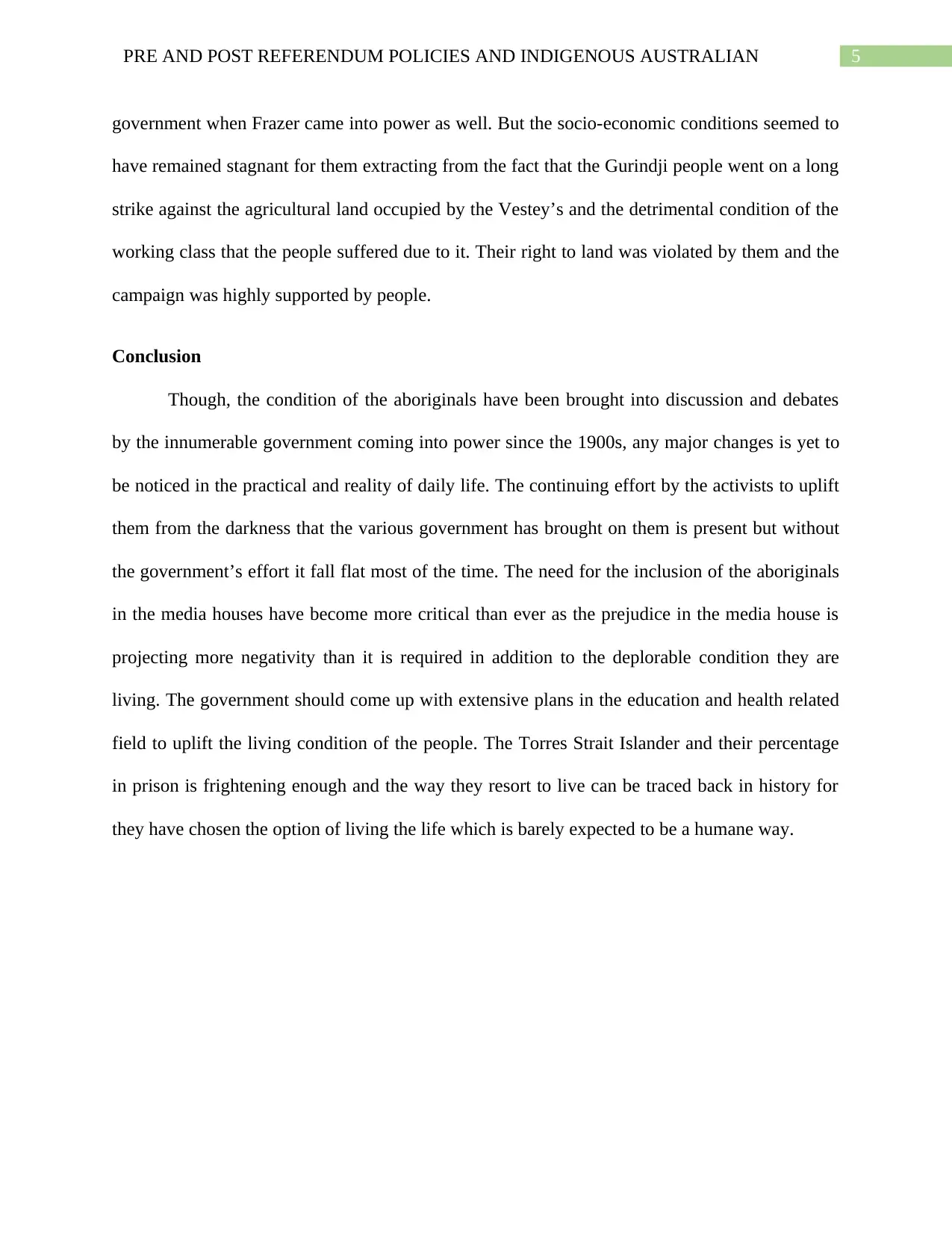
5PRE AND POST REFERENDUM POLICIES AND INDIGENOUS AUSTRALIAN
government when Frazer came into power as well. But the socio-economic conditions seemed to
have remained stagnant for them extracting from the fact that the Gurindji people went on a long
strike against the agricultural land occupied by the Vestey’s and the detrimental condition of the
working class that the people suffered due to it. Their right to land was violated by them and the
campaign was highly supported by people.
Conclusion
Though, the condition of the aboriginals have been brought into discussion and debates
by the innumerable government coming into power since the 1900s, any major changes is yet to
be noticed in the practical and reality of daily life. The continuing effort by the activists to uplift
them from the darkness that the various government has brought on them is present but without
the government’s effort it fall flat most of the time. The need for the inclusion of the aboriginals
in the media houses have become more critical than ever as the prejudice in the media house is
projecting more negativity than it is required in addition to the deplorable condition they are
living. The government should come up with extensive plans in the education and health related
field to uplift the living condition of the people. The Torres Strait Islander and their percentage
in prison is frightening enough and the way they resort to live can be traced back in history for
they have chosen the option of living the life which is barely expected to be a humane way.
government when Frazer came into power as well. But the socio-economic conditions seemed to
have remained stagnant for them extracting from the fact that the Gurindji people went on a long
strike against the agricultural land occupied by the Vestey’s and the detrimental condition of the
working class that the people suffered due to it. Their right to land was violated by them and the
campaign was highly supported by people.
Conclusion
Though, the condition of the aboriginals have been brought into discussion and debates
by the innumerable government coming into power since the 1900s, any major changes is yet to
be noticed in the practical and reality of daily life. The continuing effort by the activists to uplift
them from the darkness that the various government has brought on them is present but without
the government’s effort it fall flat most of the time. The need for the inclusion of the aboriginals
in the media houses have become more critical than ever as the prejudice in the media house is
projecting more negativity than it is required in addition to the deplorable condition they are
living. The government should come up with extensive plans in the education and health related
field to uplift the living condition of the people. The Torres Strait Islander and their percentage
in prison is frightening enough and the way they resort to live can be traced back in history for
they have chosen the option of living the life which is barely expected to be a humane way.
⊘ This is a preview!⊘
Do you want full access?
Subscribe today to unlock all pages.

Trusted by 1+ million students worldwide

6PRE AND POST REFERENDUM POLICIES AND INDIGENOUS AUSTRALIAN
References
Aiatsis.gov.au (2020). THE POLICY of ASSIMILATION. [Online] Aiatsis.gov.au. Available at:
https://aiatsis.gov.au/sites/default/files/catalogue_resources/18801.pdf [Accessed 18 Jan.
2020].
Australian Government Department of Veteran Affairs (2020). Indigenous Australians at War.
[Online] Australian Government Department of Veteran Affairs. Available at:
https://www.dva.gov.au/i-am/aboriginal-andor-torres-strait-islander/indigenous-
australians-war [Accessed 18 Jan. 2020].
Daley, P. (2017). Its 50 years since Indigenous Australians first “counted”. Why has so little
changed?’ The Guardian, 19.
Foley, G. (2017). Harold Holt's death and why the 1967 referendum failed Indigenous people |
Gary Foley. [Online] the Guardian. Available at: https://www.theguardian.com/australia-
news/2017/may/27/harold-holts-death-and-why-the-1967-referendum-failed-indigenous-
people [Accessed 18 Jan. 2020].
McCallum, K., Waller, L., & Dreher, T. (2016). Mediatisation, marginalisation and disruption in
Australian indigenous affairs.
McCausland, R. (2020). SPECIAL TREATMENT - THE REPRESENTATION OF ABORIGINAL
AND TORRES STRAIT ISLANDER PEOPLE IN THE MEDIA. [Online] Journal of
Indigenous Policy. Available at:
http://classic.austlii.edu.au/au/journals/JlIndigP/2004/16.html [Accessed 18 Jan. 2020].
Moran, A. (2011). Multiculturalism as nation-building in Australia: Inclusive national identity
and the embrace of diversity. Ethnic and racial studies, 34(12), 2153-2172.
References
Aiatsis.gov.au (2020). THE POLICY of ASSIMILATION. [Online] Aiatsis.gov.au. Available at:
https://aiatsis.gov.au/sites/default/files/catalogue_resources/18801.pdf [Accessed 18 Jan.
2020].
Australian Government Department of Veteran Affairs (2020). Indigenous Australians at War.
[Online] Australian Government Department of Veteran Affairs. Available at:
https://www.dva.gov.au/i-am/aboriginal-andor-torres-strait-islander/indigenous-
australians-war [Accessed 18 Jan. 2020].
Daley, P. (2017). Its 50 years since Indigenous Australians first “counted”. Why has so little
changed?’ The Guardian, 19.
Foley, G. (2017). Harold Holt's death and why the 1967 referendum failed Indigenous people |
Gary Foley. [Online] the Guardian. Available at: https://www.theguardian.com/australia-
news/2017/may/27/harold-holts-death-and-why-the-1967-referendum-failed-indigenous-
people [Accessed 18 Jan. 2020].
McCallum, K., Waller, L., & Dreher, T. (2016). Mediatisation, marginalisation and disruption in
Australian indigenous affairs.
McCausland, R. (2020). SPECIAL TREATMENT - THE REPRESENTATION OF ABORIGINAL
AND TORRES STRAIT ISLANDER PEOPLE IN THE MEDIA. [Online] Journal of
Indigenous Policy. Available at:
http://classic.austlii.edu.au/au/journals/JlIndigP/2004/16.html [Accessed 18 Jan. 2020].
Moran, A. (2011). Multiculturalism as nation-building in Australia: Inclusive national identity
and the embrace of diversity. Ethnic and racial studies, 34(12), 2153-2172.
Paraphrase This Document
Need a fresh take? Get an instant paraphrase of this document with our AI Paraphraser
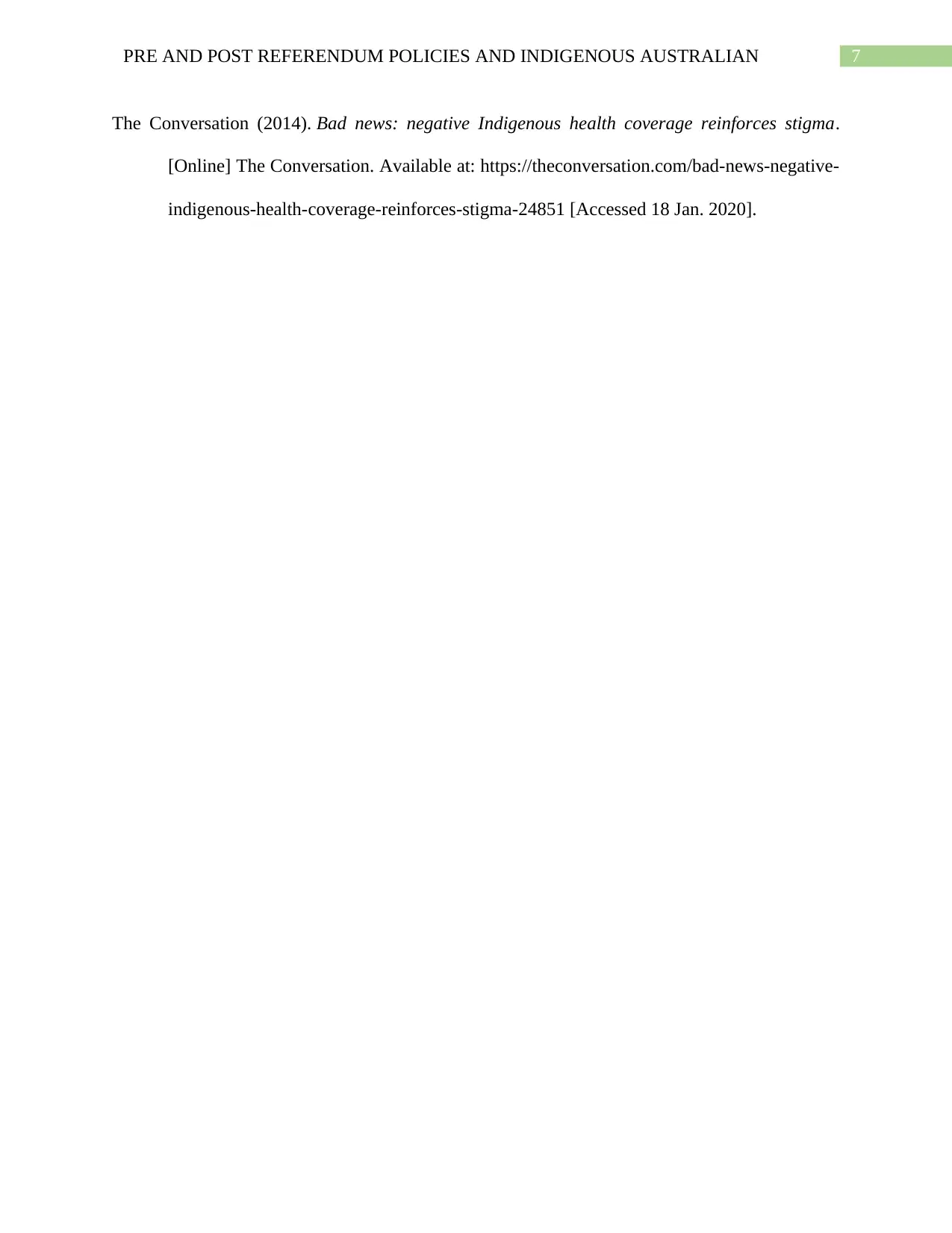
7PRE AND POST REFERENDUM POLICIES AND INDIGENOUS AUSTRALIAN
The Conversation (2014). Bad news: negative Indigenous health coverage reinforces stigma.
[Online] The Conversation. Available at: https://theconversation.com/bad-news-negative-
indigenous-health-coverage-reinforces-stigma-24851 [Accessed 18 Jan. 2020].
The Conversation (2014). Bad news: negative Indigenous health coverage reinforces stigma.
[Online] The Conversation. Available at: https://theconversation.com/bad-news-negative-
indigenous-health-coverage-reinforces-stigma-24851 [Accessed 18 Jan. 2020].
1 out of 8
Your All-in-One AI-Powered Toolkit for Academic Success.
+13062052269
info@desklib.com
Available 24*7 on WhatsApp / Email
![[object Object]](/_next/static/media/star-bottom.7253800d.svg)
Unlock your academic potential
Copyright © 2020–2025 A2Z Services. All Rights Reserved. Developed and managed by ZUCOL.
